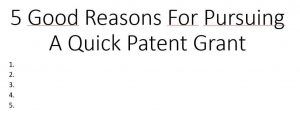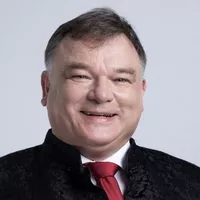- within Intellectual Property topic(s)
- with readers working within the Technology, Media & Information and Pharmaceuticals & BioTech industries
- within Technology topic(s)
This is where I am coming from: I have developed a course for accelerating the grant of a European Patent from four (4) years to only one (1) year, click here.
So far so good.
But now how to market that product "EP patent in only one year"?
There are the same three motives for doing marketing, again and again:
- fear
- greed
- a vision
But which one to apply for which customer avatar?
Have you ever asked yourself when and why an expedited patent grant is important?
Market Research Using LinkedIn
I have used LinkedIn for finding out more from my peers, and this is what I have posted:
Who needs a fast patent grant?
I cannot come up with any good reason why a granted patent is better than a pending patent application.
Maybe for negotiation purposes in licensing matters? Or when there is a pending public tender for supplying goods to a government?
and this came together with an empty list of reasons, which is quite provocative in that context:

My LinkedIn posts are here https://www.linkedin.com/feed/update/urn:li:activity:6899543190865551360 and here https://www.linkedin.com/feed/update/urn:li:activity:6899543063581007872
There were several – not too many – comments left on these posts.
Mikko Piironen wrote this:
It is difficult to start court proceedings if you don't have anything granted. The control is not fully in your hands as you need first to get your patent granted. At least in most of the jurisdictions. I am not a licensing expert, however, starting negotiations with pending applications only doesn't sound very promising to me. If the alleged infringer doesn't want to pay or even negotiate seriously, what would you do? Should you also expect third party observations (just to slow down) and subsequent opposition and/or invalidation proceedings?
For important inventions it is better to have both. With very high renewal fees and also possible validation fees for several grants you need deep pockets in Europe. I am not a big fan of UP, however, in some cases it provides strategies that may improve proprietors possibilities.
In China, a very good reason is to get money from the government (patent subsidies), though such subsidies are supposed to reduce by at least 25% per year, and completely disappear by 2025.
There are a few reasons I can think of.
1. Present infringement
2. The invention is in a fast moving or transient market where most
of the benefit will be realized in the first couple years. For
example, a new face mask design for COVID...
3. You're looking to raise startup money based on the patent,
and the patent may be used as collateral.
4. Lack of access to inventors.If you want around too long, people
tend to leave the company or become unavailable.
5. You might have access to free acceleration at the PTO due to
inventor age, specific areas of invention etc.
In contrast, there are situations where you want to prosecute as slowly as possible. For example, drug patents must be filed and prosecuted as slowly as possible because it takes years to get the required regulatory approvals and develop the market. In such cases, last days of patent term are worth millions, and the first days almost nothing. Attorneys that draft pharma cases always file a provisional first, then file the non-provisional on the day the provisional is set to expire because it adds a full year to the end date when the patent expires. They also fight like crazy for every single day of PTA and PTE.
I can think of a few reasons. Fast grant means you're less likely to get caught up in changes in law/changes in attitude. We've all been in situations where we end up fighting with an examiner who is using ex post facto reasoning, especially when it comes to inventive step. Also, sometimes clients just want to be able to have some certainty over scope early, so that they understand the limits of their monopoly. Lastly, some clients are very results focused and just want the process finished, so they can tick it off the list and move on. We might live and breathe patents, but many clients see patents as nothing more than a step in a bigger journey.
You can not enforce a patent application but you can with a granted patent. There is always a slip between the cup and the lip
For one client of mine, it's simple: a competitor is clearly infringing. We are pushing for expedited examination because you can't enforce an application.
Of course, a divisional will keep the case alive, hopefully until after all the litigation is completed.
Damages in the contracting states of EPOrg are computed for period starting from a B1 date (in Poland it may be even shifted if correction of translation needs to be filled). Of course damages are not always crucial and sometimes may not even cover all the costs of litigation but still there is a psychological effect on assumed infringers and their the risk involved with their evil enterprises increases :).
to which Tarik Kapić replied:
Well, not all countries have this system – the starting point for calculating damages is often the date of the publication of the application.
Marek Bury again:
Tarik Kapić, well that is what provisional protection is for. But it takes a lot of resources to secure it in all EPC countries. I generally agree with doubts expressed by Martin Schweiger, I have just give some exceptions ;)
You can get injunction with a granted patent while you cannot have it with just a patent application. If infringer is "agile" it can happen that without injunction you cannot find any money unless injunction was obtained in the right time.
Granted patent ranks higher in algorithms for tangible assets valuation and can impact stock prize more.
Sure seems like you came up with two common reasons.
For businesses contemplating multiple national phase entries, prosecuting in a country like the US first can be very helpful in understanding what may issue in a foreign jurisdiction. I see a lot of Examiners that largely mirror the rejections subject to local requirements. When these Examiners see an issuance, foreign filings TEND to follow US issuances. So getting that issuance before the 30-month national phase deadline or 31st-month deadline can save a mint in prosecution costs.
If you have ever been in litigation and you need a counterclaim to bring the other party to the table... let me tell you it is pretty nice to be able to file some carefully crafted claims and submit for expedited examination.
What I cannot figure out is WHY business owners who are making money from their patented invention don't keep a continuation/divisional pending. Pure silliness I say.
to which Jesse Fenty replied:
Matthew Wahlrab Do other countries besides the U.S. have the Continuation practice?
Matthew Wahlrab answered that question right away:
Jesse Fenty thanks for asking. The major markets have a similar concept to the US continuation where you can claim disclosed but unclaimed subject matter. It's more common to use what we in the US refer to a Divisional.
One of the objectives a solid IP practice will achieve is creating optionality for the owner of the portfolio. A requirement is always complying with a budget. A need is always ensuring there is enough budget to validate market demand.
I say all of this because in Europe, if you want to engage in keeping a case alive, and evidence suggests you should, prosecution in this jurisdiction is aided by opening prosecution with claims that were included in the original PCT filing.
For this reason it isn't uncommon to have over 100 claims in a PCT with many independent claims. It's a challenge balancing such robust disclosure to support so many claims for many jurisdictions. Especially when capital often must be deployed to commercially validate the client's idea. So balancing risk, upside, and cost is the name of the game.
And seriously, if your idea is worth money to you or someone else, get support/direct market feedback to determine whether your IP portfolio should have a continuation practice.
Back to the original question. I was reminded today about "essential claims" in licensing agreements. In some agreements, securing essential claims in prosecution comes with enhanced royalties and other payment triggers.
And finally Kevin E. Noonan:
I suspect certainty (in obtaining the patent and the specific granted patent claims) with a pending continuation or divisional to obtain (perhaps) greater scope or patent ably distinct aspects of the invention
The intermediate result is that I have obtained sixteen (16) good reasons for accelerating grant of a patent.
That is not a bad result at all.
I still do not know whether these reasons are good, but at least there are reasons.
Conclusion
What I wanted to show here is that LinkedIn is a wonderful tool for gaining market insights.
My method works for all areas of life, from "can I freeze bread?" to patent-specific matters.
Do the same if you need feedback from others.
And my new set of slides with sixteen (16) good reasons for expediting patent grant will follow soon.
Martin "LinkedIn" Schweiger
IP Lawyer Tools by Martin Schweiger
Originally published 06 March 2022
The content of this article is intended to provide a general guide to the subject matter. Specialist advice should be sought about your specific circumstances.

